Description:
- The recommended method of creating your database is to use database configuration assistant (dbca). however, if you create your database manually using the create database statement, then oracle asm enables you to create a database.
- We have oracle binaries and Grid infrastructure already installed in this server.
- We are going to create database on existing Asm file system
- We are using Create Database command to create a new oracle database on ASM file system from the command line.
- This method is helpful when we don’t have console access to the server to use the DBCA .
Steps for Manual Oracle 12cR2 Database creation on ASM filesystem
Step 1: Check the Services are up and running
crsctl status resource -t
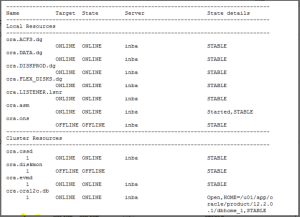
Step 2: Login as ASM instance and check the filesystem is mounted .
- Firstly we have to check the ASM file system is mounted or not if its not mounted the asm file system we do not create the database so it’s must started the CRS services then start the database creation.
SQL> select name,block_size,allocation_unit_size,state,type,total_mb,free_mb from v$asm_diskgroup;

Step 3: Create the Initialization Parameter File in dbs location.
*.audit_file_dest='/u01/app/oracle/admin/orcl/adump' *.audit_trail='db' *.compatible='12.2.0' *.control_files='+DATA' *.db_block_size=8192 *.db_create_file_dest='+DATA' *.db_name='orcl' *.diagnostic_dest='/u01/app/oracle' *.dispatchers='(PROTOCOL=TCP) (SERVICE=orclXDB)' *.filesystemio_options='setall' *.local_listener=LISTENER_ORCL *.job_queue_processes=1000 *.log_buffer=10485760 *.nls_language='AMERICAN' *.nls_territory='AMERICA' *.open_cursors=300 *.pga_aggregate_target=2981m *.processes=500 *.remote_login_passwordfile='EXCLUSIVE' *.session_cached_cursors=300 *.sga_target=8940m *.undo_tablespace='UNDOTBS1'
[oracle@inba ~]$ cd /u01/app/oracle/product/12.2.0.1/dbhome_1/dbs
[oracle@inba ~]$ export ORACLE_SID=orcl
[oracle@inba ~]$ export ORACLE_HOME=$DB_HOME
[oracle@inba ~]$ export PATH=$ORACLE_HOME/bin:$BASE_PATH
[oracle@inba ~]$ export LD_LIBRARY_PATH=$ORACLE_HOME/lib:/lib:/usr/lib
[oracle@inba ~]$ export
CLASSPATH=$ORACLE_HOME/JRE:$ORACLE_HOME/jlib:$ORACLE_HOME/rdbms/jlib
[oracle@inba ~]$
[oracle@inba ~]$ sqlplus / as sysdba
SQL*Plus: Release 12.2.0.1.0 Production on Tue May 25 15:31:14 2021
Copyright (c) 1982, 2016, Oracle. All rights reserved.
Connected to an idle instance.
SQL> startup nomount pfile=’/u01/app/oracle/product/12.2.0.1/dbhome_1/dbs/initorcl.ora’
ORA-09925: Unable to create audit trail file
Linux-x86_64 Error: 2: No such file or directory
Additional information: 9925
Step 4: create audit trail file adump directory because we are facing that error ORA-09925
[oracle@inba ~]$ cd /u01/app/oracle/admin/orcl
[oracle@inba orcl]$ ls
xdb_wallet
[oracle@inba orcl]$ mkdir adump
[oracle@inba orcl]$ ls -lrth
total 8.0K
drwxr-xr-x. 2 oracle asmadmin 4.0K May 25 11:07 xdb_wallet
drwxr-xr-x. 2 oracle oinstall 4.0K May 25 15:41 adump
[oracle@inba orcl]$ cd
Step 5: startup the database in no mount stage. Though we haven’t created database yet, here we’re checking if database starts up on created pfile.
export ORACLE_SID=orcl
export ORACLE_HOME=$DB_HOME
export PATH=$ORACLE_HOME/bin:$BASE_PATH
export LD_LIBRARY_PATH=$ORACLE_HOME/lib:/lib:/usr/lib
export CLASSPATH=$ORACLE_HOME/JRE:$ORACLE_HOME/jlib:$ORACLE_HOME/rdbms/jlib
sqlplus / as sysdba
SQL> startup nomount pfile=’/u01/app/oracle/product/12.2.0.1/dbhome_1/dbs/initorcl.ora’
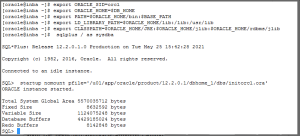
Step 6: Now the database to add in ASM .
[oracle@inba ~]$ srvctl add database -d orcl -o /u01/app/oracle/product/12.2.0.1/dbhome_1
![]()
Step 7: Execute CREATE DATABASE command to creates data files, control files, redo log files, the system tablespace along with the data file associated with it.
CREATE DATABASE orcl
MAXLOGFILES 5
MAXLOGMEMBERS 3
MAXDATAFILES 200
MAXINSTANCES 1
LOGFILE
GROUP 1 (‘+DATA’) SIZE 100M,
GROUP 2 (‘+DATA’) SIZE 100M,
GROUP 3 (‘+DATA’) SIZE 100M
DATAFILE ‘+DATA’ SIZE 3000M EXTENT MANAGEMENT LOCAL SYSAUX DATAFILE ‘+DATA’ SIZE 2000M UNDO TABLESPACE UNDOTBS1 DATAFILE ‘+DATA’ SIZE 300M AUTOEXTEND OFF DEFAULT TEMPORARY TABLESPACE TEMP TEMPFILE ‘+DATA’ SIZE 200M REUSE AUTOEXTEND OFF
CHARACTER SET AL32UTF8;

Step 8: Check the database mode and created datafile & logfile
select name,open_mode from v$database;
select name from v$datafile;
select member from v$logfile;
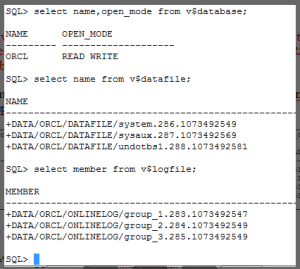
Now the database contains data files , control files, redo log files, the SYS and SYSTEM users, and all the internal data dictionary tables, but No data dictionary views created.so we do run the scripts to build data dictionary views
Step 9 : In that ORACLE_HOME/rdbms/admin directory, a scripts need to be run to complete the database data dictionary creation.so below scripts to build data dictionary views.
@?/rdbms/admin/catalog.sql; —–>CATALOG.sql creates the data dictionary views
@?/rdbms/admin/catproc.sql; ——>CATPROC.sql creates the objects required to use PL/SQL.
@?/sqlplus/admin/pupbld.sql; ——>pupbld.sql creates the default roles and profiles.
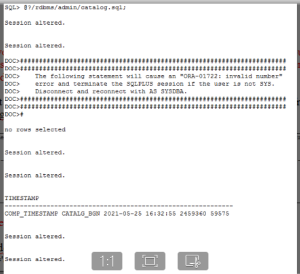
Step 10:Create a Server parameter file because the database created in pfile.
create spfile from pfile=’/u01/app/oracle/product/12.2.0.1/dbhome_1/dbs/initorcl.ora’;
Step 11: Add a datafile in ASM instance .
create tablespace users datafile ‘+DATA’ SIZE 300M;
select name from v$datafile;
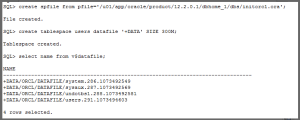
Step 12: Check the status of database running or not in ASM service
[oracle@inba ~]$ srvctl status database -d orcl
Database is not running.
Step 13 : To start the database in ASM service
[oracle@inba ~]$ srvctl start database -d orcl
[oracle@inba ~]$ srvctl status database -d orcl
Database is running.
Step 14: Again to check the status of database in ASM and there are two database created running in ASM.
[oracle@inba ~]$ . grid.env
[oracle@inba ~]$ crsctl status resource -t

[oracle@inba ~]$ ps -ef|grep pmon

We have successfully created manual database in ASM.
